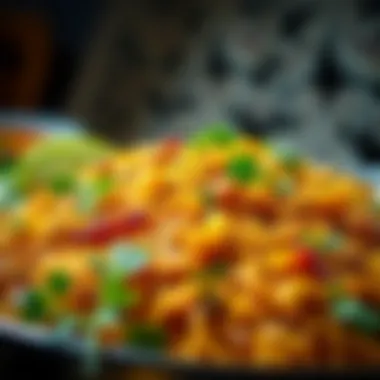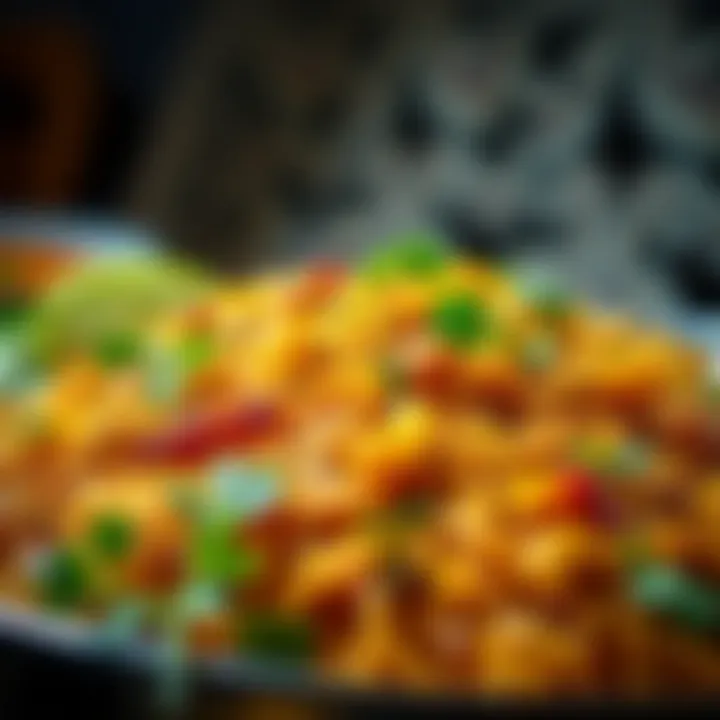Discovering the Flavorful Indian Restaurants in Karama


Intro
Karama, a bustling neighborhood in Dubai, stands out as a culinary hub that reflects the essence of Indian gastronomy. This locale isn’t just a home for expats, but also a testament to Dubai's rich tapestry of cultures, especially Indian. With the sounds of sizzling spices wafting through the air, a plethora of Indian restaurants beckons food enthusiasts from various walks of life.
The evolution of Indian cuisine in Karama mirrors the broader culinary journey within the city, encompassing flavors that range from traditional fare to cutting-edge fusion dishes. As we set forth on this exploration of Karama's Indian restaurants, it’s essential to grasp both the local dining culture and the historical roots that have shaped this flavorful landscape.
In this article, we aim to spotlight not just the must-try dishes but also the dining styles that resonate with a diverse audience. Whether you are an investor seeking opportunities in this vibrant sector or a food lover eager to discover culinary delights, understanding the dynamics of Karama’s Indian dining scene will prepare you for an unforgettable experience.
Historical Context of Indian Cuisine in Dubai
Understanding the historical context of Indian cuisine within the bounds of Dubai isn't just for culinary enthusiasts; it's critical for anyone looking to grasp the rich tapestry of cultural influence that shapes the city today. Over the years, the melding of flavors from India has carved out a unique niche in Dubai's gastronomic landscape, particularly in areas like Karama, where the community thrives on its diverse culinary heritage. This section will illuminate how early influences paved the way for the vibrant restaurant scene we see now, the emergence of Indian immigrant communities, and how these elements have merged to form a distinct culinary identity in Karama.
Early Influences
The roots of Indian cuisine in Dubai can be traced back to the late 19th and early 20th centuries when trade routes between the Indian subcontinent and the Arabian Peninsula began to strengthen. Merchants traveled with spices and culinary techniques that, once introduced to local chefs, fused with traditional Emirati flavors. This era marked the initial sprinkling of Indian spices in Dubai's food scene.
For instance, techniques like marinating meats with yogurt and spices reflect this blend. Dishes such as Biryani, which are now staples in many restaurants, owe their popularity to these early culinary exchanges. The influence of the Indian community was subtle but significant, showcasing the potential for cross-cultural culinary innovation.
Growth of Indian Immigrant Communities
As the years rolled on, the socio-economic landscape transformed significantly. The 1960s saw a sharp influx of Indian workers who were drawn to Dubai’s booming economy—a trend that continued through the following decades. With them, they brought not just their labor but also their culinary practices and preferences.
Today, it's estimated that around 30% of Dubai's population is of Indian descent. This demographic shift meant that Indian restaurants began sprouting up like wildflowers, catering to both the growing community and the curious expatriates. Some establishments began blending traditional recipes with modern interpretations, attracting a wider audience and allowing for a continuous evolution of flavors.
Integration of Culinary Traditions
The integration of culinary processes took place not just in professional kitchens but also in home-cooked meals shared among families and friends. Traditional Indian techniques—like slow-cooked curries and freshly baked naan—brought an authenticity that resonated with food lovers. On the one hand, these traditional dishes preserved their essence; on the other, innovation paved the way for fusion dishes that combined spices with local ingredients—think saffron-infused chicken tikka or spiced hummus.
This multiple heritage is particularly visible in Karama, where one can find not just eateries offering classic dishes but also those that add a modern twist to traditional fare, creating an entirely new culinary experience.
The backdrop of Dubai, which has always been a melting pot of cultures, supports this continuous exchange and evolution of culinary practices.
"Culinary integration is not just about mixing flavors; it’s about harmonizing cultures and creating new identities."
This historical narrative showcases how Indian cuisine has intricately woven itself into the fabric of Dubai, particularly in Karama, giving diners a delicious glimpse into a community's journey through flavor.
The Essence of Karama’s Dining Scene
The dining landscape in Karama is a reflection of a vibrant tapestry woven from the threads of cultural diversity and culinary excellence. This area, bustling with activity, serves as a focal point for Indian cuisine in Dubai. Here, the essence is not just about what’s on the plate; it embodies the stories, traditions, and communal aspects that contribute to a remarkable dining experience. In a global city where culinary trends shift like sand, Karama has held steadfast, maintaining authenticity while embracing innovation.
Location and Accessibility
Nestled conveniently within Dubai, Karama's location is pivotal for diners. The area is easily accessible via the Dubai Metro, making it a favorite not only for locals but also for tourists seeking genuine Indian fare. With key attractions nearby, such as the Dubai Frame and cultural heritage sites, Karama attracts footsteps from all corners. Restaurants line the streets, inviting passersby to indulge in the diverse culinary offerings. This accessibility plays a vital role in its popularity; folks can pop in for a quick bite after a day of exploration or enjoy a leisurely meal with family and friends.
Diversity of Offerings
Karama is a melting pot of flavors. The Indian restaurants here boast a rich variety of dishes hailing from different regions of India, ensuring something tantalizing for every palate. One can enjoy the fiery curries from North India, such as a classic Butter Chicken, or relish the aromatic biryanis typical of the Hyderabadi style. Additionally, South Indian delicacies like Dosas and Idlis can be effortlessly found alongside street-style chaat, all showcased in charming eateries.
- Regional Highlights:
- North Indian Cuisine: Rich gravies and flatbreads
- South Indian Cuisine: Lighter, rice-based preparations
- Street food: Quick bites like pav bhaji and pani puri
This diversity not only satisfies varied tastes but also brings together people from different backgrounds, enhancing the vibrant atmosphere.
Cultural Significance
The cultural significance of dining in Karama transcends mere consumption of food. Each dish tells a story of heritage, family traditions, and regional pride. The Indian community heavily influences local culture, with dining often seen as a communal activity.
Practices such as family-style meals and sharing dishes are prevalent, encapsulating the spirit of togetherness. Food festivals and special occasions become opportunities for restaurants to showcase unique dishes that honor family recipes passed through generations.
Moreover, the role of Indian restaurants in Karama isn’t just about food. They serve as community hubs where celebrations and gatherings occur, contributing to social cohesion. The ambient environment created in these establishments nurtures friendships and promotes camaraderie, making Karama's dining scene a vital part of the city's cultural fabric.
"Food is the universal language of the human experience; in Karama, it speaks volumes about love, connection, and identity."
Popular Indian Restaurants in Karama


When it comes to Indian cuisine in Dubai, Karama stands out as a treasure trove of flavors and experiences. This neighborhood is teeming with restaurants that not only showcase the diverse culinary palette of India but also cater to a wide demographic. For both locals and expatriates, these establishments are more than mere dining spots; they embody the culture, community, and authentic tastes that Indian cuisine has to offer. Exploring the variety of popular Indian restaurants in Karama reveals underlying trends in dining preferences, demographic tastes, and evolving culinary innovations.
Overview of Notable Establishments
In Karama, the landscape of Indian dining is vibrant and varied. From humble eateries to bustling fine dining spots, there’s something for every palate.
- Ravi Restaurant: Known for its generous portions and authentic taste, this establishment has been a favorite for years. Their butter chicken and biryani draw in crowds day and night.
- Khana Khazana: Its eclectic menu combines North and South Indian flavors, offering everything from dosa to tandoori. This place is famed for its warm hospitality as well.
- Aappa Kadai: With a niche focus on South Indian dishes, this restaurant serves up idlis and vadas which are celebrated for their traditional preparation methods.
Each of these establishments tells its own story through its menu and service, contributing to the overall culinary experience in Karama.
Cuisine Specialties of Each Restaurant
The real charm of Indian dining in Karama lies in the specialties that each restaurant brings to the table.
- Ravi Restaurant heavily focuses on Mughlai dishes. Their signature butter chicken is simmered to perfection, balancing rich flavors with velvety textures. For spice lovers, their lamb vindaloo can be a real treat.
- At Khana Khazana, the thali is a spectacle—an assortment of dishes that lets diners sample various flavors in one go. This restaurant often incorporates seasonal ingredients, ensuring freshness in every bite.
- Aappa Kadai takes pride in its unique South Indian fare, especially their Mysore masala dosa paired with coconut chutney, which offers a taste of authenticity that locals admire.
The fusion of regional specialties not only helps preserve culinary traditions but also attracts food enthusiasts eager to explore authentic Indian flavors.
Ambiance and Dining Experience
Dining in Karama isn't just about the food; it's about the entire experience that comes with it. From the moment you walk into a restaurant, the decor and atmosphere play a crucial role in shaping your perception.
- Ravi Restaurant has a no-frills setup that’s always buzzing with energy. The casual setting suits a quick meal after a long day, making it popular among the working crowd.
- In contrast, Khana Khazana adopts a more refined approach. It features traditional Indian decor, creating a cozy environment ideal for family gatherings. The service is attentive, enhancing the dining experience without feeling intrusive.
- Aappa Kadai embraces a blend of modern and traditional aesthetics. Bright colors and murals depicting Indian scenes add to the charm, making it not just a meal but an aesthetic experience as well.
"The cooking comes alive not only through flavors but also in the atmosphere and the service, creating a holistic dining experience."
Signature Dishes to Indulge In
Karama's Indian restaurants offer more than just meals; they serve a tasty window into Indian culture and tradition. Signature dishes hold a special place in this culinary landscape, capturing the attention of food enthusiasts and casual diners alike. These dishes not only highlight the unique flavors and ingredients of India but also showcase the skills and creativity of the chefs behind them. Understanding the significance of these culinary staples helps to appreciate not only the eateries in Karama but the vibrant Indian heritage that influences each bite.
Regional Specialties
Every region of India boasts its own culinary delights, translating into a rich tapestry of flavors appearing in Karama's eateries.
- North Indian Cuisine: Home to dishes like Butter Chicken and Paneer Tikka, these meals often rely on creamy gravies and aromatic spices. The use of tandoor cooking is a hallmark here, which gives the food that unique smoky flavor that is hard to resist.
- South Indian Flavors: Think crispy Dosa and hearty Sambar. These dishes are celebrated for their rice and lentils base, showcasing a lighter yet distinctly spicy palate. The tang from tamarind and the inclusion of coconut are key features.
- East Indian Influences: Don't miss the chance to try Fish Curry, often found in the Bengali cuisine, with its subtle yet complex spice mix. Alternatively, the sweetness of Macher Jhol is a popular comfort food among locals, enriching Karama's culinary offering.
- West Indian Treats: Items like Dhokla, a fluffy fermented snack from Gujarat, or the spicy Goan Prawn Curry add a different dimension with their bold flavors and transformative cooking techniques.
These regional specialties are a mouth-watering representation of India’s vast culinary diversity, giving you a reason to indulge in culture, one dish at a time.
Spice Profiles and Flavor Combinations
When we talk about Indian food, we can't overlook the magic of spices. They are the lifeblood of Indian cuisine, and each dish tells a story of its origins through its unique blend of flavors.
- Heat Levels: Dishes can range from mild to fiery, often tailored to local preferences. For instance, a Biryani can contain a balanced spice level, while a Vindaloo is renowned for its intense heat.
- Complex Layering: Signature dishes often incorporate multiple spices that complement rather than overpower each other. Garam Masala—a mix of cardamom, cinnamon, and cloves—plays a crucial role in achieving this balance.
- Fresh Ingredients: Many Indian chefs also emphasize using fresh herbs and spices. The bright notes of cilantro and the warmth of ginger add depth to meals like Palak Paneer or Chaat.
It’s this intricate dance of spices that transforms simple ingredients into extraordinary dishes, making the dining experience in Karama so memorable.
Vegetarian Versus Non-Vegetarian Options
Karama’s restaurants stand out with their extensive range of offerings that cater to both vegetarian and non-vegetarian guests. It's important to know the differences:
- Vegetarian Options: India has a rich vegetarian tradition that’s celebrated across Karama. Dal Makhani and Palak Paneer are not just crowd-pleasers; they represent a commitment to plant-based dining that can rival any meat dish.
- Non-Vegetarian Delights: For meat lovers, dishes like Biryani and Kebabs take center stage. Their rich flavors and satisfying textures offer a completely different but equally delightful experience.
- Fusion Dishes: Some eateries are innovating, creating fusion meals that incorporate features from both realms, such as Vegetarian Biryani packed with flavorful spices or Meat-Free Kebabs utilizing lentils and chickpeas.
Both sides of the menu shine, showcasing the flexibility and creativity of Indian culinary culture. Whether you lean towards vegetarian or non-vegetarian, there's a dish waiting to tantalize your taste buds in Karama.
Dining Styles and Experiences
Understanding the diverse dining styles and experiences within Karama's Indian restaurant landscape shines a light on the choices available to both locals and tourists. From laid-back casual eateries to elegant fine dining establishments, these venues cater to a wide spectrum of preferences and occasions. The way one chooses to dine often hinges on various factors such as the purpose of the outing, the size of the gathering, and personal taste. Thus, examining these elements helps highlight not just the culinary offerings but also the social experiences intertwined with Indian cuisine in this vibrant neighborhood.
Casual Dining versus Fine Dining


Casual dining in Karama is characterized by a relaxed atmosphere, vibrant decor, and an emphasis on accessibility. Restaurants like Saravana Bhavan easily epitomize this category, serving hearty South Indian fare in a family-friendly setting. Diners can expect quick service, an affordable menu, and the chance to enjoy meals at their own pace. These spots often attract groups, families, and students, creating a lively and welcoming vibe. On the other hand, fine dining venues such as Rang Mahal present a more upscale option. With refined decor, attentive service, and sophisticated dishes that take traditional recipes to an innovative level, such restaurants are perfect for special occasions or romantic dinners.
The distinction between the two styles is clear in the dining experience offered. In casual spots, the menus are broad and cater to many tastes without being overly complicated, while fine dining focuses on a curated selection of exquisite dishes that highlight the chef’s craft.
Takeaway and Delivery Services
In recent years, takeaway and delivery services have shifted the dining landscape significantly. Many restaurants, regardless of their primary dining style, have embraced this trend to better serve their customers. For instance, Biryani Pot and Al Iqbal have tailored their menus for seamless transportation, ensuring that the flavors survive beyond the restaurant’s walls.
With just a click, patrons can enjoy their favorite meals at home, making Indian cuisine more accessible than ever. The trend caters well to busy professionals and families who may not have the time to dine out but still crave authentic flavors. Each restaurant has carved its niche in this competitive market, with many offering combo meals or special discounts on delivery orders. A survey of takeaway service user preferences reveals a growing inclination toward healthier options and quality ingredients, pushing restaurants to adapt accordingly.
Catering Services for Special Events
When it comes to hosting special gatherings, many prefer to have Indian cuisine as a centerpiece for events, from weddings to corporate functions. Catering services from restaurants like Mughal Mahal offer a multitude of options that can be customized based on themes, guest preferences, and dietary restrictions. The beauty of Indian cuisine lies in its vast range, which includes vegetarian, vegan, and non-vegetarian dishes.
Opting for catered Indian food ensures a memorable experience, as guests can savor a lavish buffet filled with classic dishes such as Butter Chicken, Paneer Tikka, and Samosas. Moreover, the cultural significance of sharing a meal enhances the communal spirit of events. Restaurateurs often emphasize quality and presentation, ensuring that food not only tastes good but also looks exquisite upon reaching the table. This aspect of dining also allows Indian restaurants in Karama to foster loyalty and create lasting relationships with customers.
"Dining is not just about food; it's about the shared experience, the stories that unfold over a meal, and the connections it fosters."
In summary, exploring different dining styles in Karama underscores the adaptability and richness of Indian cuisine. Given the array of experiences from casual dining to specialized catering, there lies an opportunity for culinary ventures to thrive, keeping pace with customer expectations and market dynamics.
Customer Preferences and Trends
In understanding the culinary landscape of Indian restaurants in Karama, recognizing customer preferences and trends plays a pivotal role. These factors not only shape the offerings of restaurants but also reflect the evolving palate of both residents and expatriates. As the dining scene continues to flourish, knowing how to cater to the unique tastes of these diverse groups can result in thriving businesses and satisfied customers. Moreover, adapting to current trends can elevate a restaurant’s standing, ultimately carving a niche in an increasingly competitive market.
Dining Habits of Residents and Expatriates
Karama’s Indian restaurants find themselves in a vibrant mix of diners—ranging from lifelong Dubai residents to transient expatriates drawn by work or study. This dynamic creates a fascinating dining culture. For locals who have called Dubai home for years, there exists a certain comfort in traditional dishes, often prepared with recipes passed down through generations. For these diners, restaurants like Bombay Bites and Saravana Bhavan have become staples where familiar tastes bring nostalgia.
In contrast, expatriates often showcase greater adventurousness, eager to explore a variety of regional Indian dishes. They swing by places like Calicut Paragon, searching for authentic flavors that transport them to India—spicy Kerala-style biryanis or rich North Indian curries. Thus, while resident diners might lean towards consistency in their choices, expatriates often contribute to the diversity of customer demand by indulging in unique flavor profiles.
Influence of Health Consciousness
In recent years, health consciousness has crept into the culinary preferences across Karama. Many diners are increasingly aware of nutritional content and are gravitating towards meals that balance taste with health benefits. This shift has prompted Indian restaurants to reevaluate their menus significantly.
Diners are now on the lookout for wholesome options packed with nutrients. This includes a rise in demand for vegetarian dishes, gluten-free choices, and the thoughtful use of spices known for their health benefits. Certain restaurants, such as Vegetarian Palace, have seized this opportunity, banking on organic produce and health-focused recipes to attract a growing customer base clamoring for more mindful dining experiences.
Emerging Trends in Indian Cuisine
Trends in Indian cuisine are evolving, influenced by global culinary practices, and establishing a unique identity in Karama. One notable trend is the fusion of traditional dishes with contemporary touches or other cuisines—a departure from the classic approaches typically associated with Indian food. For instance, dishes like paneer tacos or butter chicken pizza have started to worm their way into menus, delighting diners looking for something novel.
Another trend permeating the dining scene is the focus on authenticity. Diners are increasingly turning to establishments that emphasize their roots, offering regional specialties that are hard to find anywhere else. This embrace of authenticity has prompted restaurants to spotlight their unique regional flare, such as Mumbai's street food or the heady flavors of Punjabi delicacies. As these trends unfold, they not only reshape the landscape of Karama's restaurants but also enhance the overall culinary journey for patrons exploring this richly diverse cuisine.
"Understanding the shifting taste preferences of diners is invaluable for Indian restaurants in Karama. It’s not just about food anymore; it’s about the whole experience—a delightful fusion of flavor, history, and culture."
As we delve deeper into the future outlook of Karama's Indian restaurants, it's essential to consider these preferences and trends as critical components driving their evolution.
The Role of Social Media in Marketing
In today's digital world, social media has turned into a powerful tool for businesses, especially in the restaurant sector. For Indian restaurants in Karama, embracing social media can significantly impact their visibility and customer engagement. Establishing an online presence allows these eateries to showcase their unique culinary offerings, connect with guests, and build a brand that resonates with both locals and expatriates.
Promoting Unique Culinary Offerings
Social media provides a vibrant platform for Indian restaurants to highlight their diverse menu items. From spicy biryanis to creamy butter chicken, photos of mouthwatering dishes can entice potential diners. Restaurants often employ vivid imagery alongside tantalizing descriptions to capture attention. Posts featuring signature dishes can create buzz and anticipation among food lovers.
Consider the phenomenon of food challenges. Many establishments use these as a marketing strategy. For example, a restaurant might tout its spicy curry challenge, encouraging customers to share their experiences on social media. This not only garners attention but also promotes the restaurant organically through shared experiences and word of mouth.
Digital Engagement with Customers
Engagement is key in retaining customers. Many Indian restaurants in Karama actively respond to comments and reviews on their social media platforms. This two-way communication fosters a sense of community and approachability, showing that the restaurant values its patrons' opinions. Regular polls or surfacing questions can create dialogue around dishes, preferences, or even new ideas for the menu. This form of engagement keeps the customer base active and invested.


Moreover, offering exclusive deals to followers can further boost customer interaction. A simple 'follow us for discounts' campaign can turn casual viewers into loyal customers.
The Impact of Food Bloggers and Influencers
In the age of Instagram, food bloggers and social media influencers play a crucial role in shaping dining trends. Their reach and credibility can help elevate the appeal of a Karama restaurant to new heights. When an influencer posts about a restaurant’s culinary offerings, it often leads to an influx of customers keen to try what they’ve seen online. This digital word of mouth can be more effective than traditional advertising.
Restaurants frequently collaborate with these influencers, inviting them to try their menu in exchange for a post or a review. This strategy not only increases brand awareness but also boosts authenticity, as consumers tend to trust recommendations from influencers they follow.
"Harnessing the influence of social media can help transform a restaurant’s standing within its community, bridging gaps and creating connections beyond conventional marketing practices."
In summary, social media serves as a significant marketing tool for restaurants in Karama. By effectively showcasing unique offerings, maintaining digital engagement, and collaborating with food bloggers, these establishments can cultivate a robust customer base and thrive in a competitive market.
Challenges Faced by Indian Restaurants
In the vibrant culinary landscape of Karama, Indian restaurants twinkle brightly like stars in the night sky. Yet, beneath the surface of this gastronomic glow lie several challenges that these establishments must navigate. Understanding these difficulties is crucial—not just for restaurant owners but also for investors, agents, and managers looking to tap into this lucrative market. Each challenge offers valuable insights into the dynamics of running an Indian eatery.
Competition in the Culinary Market
The competition in Karama’s dining scene is stiff, with numerous Indian restaurants vying for attention. Every corner seems to host another establishment offering familiar scents of spices and tantalizing flavors. This saturation means that differentiation becomes paramount. Restaurateurs must go beyond just serving good food; they need to develop unique concepts that will attract customers.
To stand out, many businesses have turned to niche markets. For instance, some focus on regional delicacies specific to states of India like Kerala’s seafood or the fiery dishes of Punjab. Others might cater to health-conscious consumers, offering organic and gluten-free options. Promotions, happy hours, or even loyalty programs can entice diners amid the deluge of choice. The goal is to keep their heads above water and capture a piece of the bustling market pie.
Sourcing Authentic Ingredients
One of the defining characteristics of Indian cuisine is its authenticity, which heavily relies on the quality and origin of ingredients. Unfortunately, sourcing native spices and grains, particularly in a place like Dubai, poses a significant challenge. Many restaurant owners find themselves at the mercy of suppliers who may not prioritize authenticity.
For example, the allure of turmeric, known for its anti-inflammatory properties, is only as good as its source. If the spice isn’t sourced directly from India, it may lack the vibrancy and punch that traditional dishes require. Restaurants often look for suppliers who can trace their ingredients back to local farms in India or trusted organic sources.
Moreover, fluctuating prices and supply chain disruptions can lead to increased costs, which, in turn, may affect menu prices. Balancing quality with affordability becomes a balancing act. \nUltimately, an establishment's commitment to genuineness often translates into customer loyalty, making this challenge worth overcoming.
Maintaining Consistency in Quality
Consider this: you head to your favorite Indian restaurant, anticipating the delightful explosion of flavors, but you’re met with a dish that fails to meet expectations. Such experiences can drive customers away faster than you can say "biryani." Maintaining quality and consistency across all platforms of service—dine-in, takeaway, and delivery—plays a crucial role in a restaurant’s reputation.
Training kitchen staff effectively becomes a priority. Many restaurants establish standardized recipes and cooking techniques to ensure that every dish, whether from a chef at noon or a substitute during dinner hours, maintains the same quality. A lack of consistency can also arise from using various suppliers, which might lead to different ingredient batches.
To combat this, some establishments work closely with specific vendors and build long-term relationships to stabilize their ingredient quality. Regular feedback from customers also proves vital. Restaurants may employ surveys or social media platforms, such as Facebook and Instagram, to gather insights and adapt accordingly. By creating a dynamic relationship with their clientele, these eateries can keep their culinary game strong and their diners satisfied.
"In the end, the key to success lies in overcoming these challenges with creativity, resilience, and a commitment to quality."
In summary, the Indian restaurants of Karama face distinct hurdles ranging from intense competition to sourcing challenges and maintaining consistency. By understanding and addressing these issues, stakeholders can better navigate this vibrant market, ensuring their ventures not only survive but thrive.
Future Outlook for Karama Indian Restaurants
The Indian restaurant scene in Karama is more than just a place to feast; it reflects the interplay of tradition and modernity, catering to a diverse, multicultural customer base. As Dubai continues to evolve into a global dining hub, understanding the future outlook of Karama's Indian establishments is essential for investors and stakeholders looking to seize opportunities in this vibrant market. With the rise of health-conscious dining trends and the increasing demand for these culinary experiences, Karama's restaurants stand on the brink of significant transformation.
Market Predictions and Trends
Looking ahead, the market for Indian restaurants in Karama is projected to witness steady growth. A few key elements will define this trajectory:
- Increased Demand for Authenticity: Consumers are leaning towards true-to-roots culinary experiences, seeking dishes that reflect deep cultural heritage.
- Health and Wellness Focus: As society becomes more health-conscious, there’s a growing preference for nutrient-rich, wholesome meals, steering restaurants to adapt their menus accordingly.
- Technology Integration: Online ordering and delivery services, once merely an option, have become essential. Restaurants leveraging technology for seamless delivery and customer engagement will likely pull ahead.
- Evolving Palates: The adventurous nature of modern diners—particularly among the younger populace—creates an environment ripe for experimentation with flavors, spices, and non-traditional presentations.
"The spice must flow!" This adage resonates with how essential vibrant spice offerings are becoming in attracting diners.
Innovations in Culinary Practices
To capture the attention of discerning diners, Indian restaurants in Karama are adopting innovative practices both in the kitchen and in service. Here are several noteworthy developments:
- Fusion Cuisine: The blend of Indian cuisine with international flavors is gaining traction. For example, expect to find dishes like Tandoori Sushi or Biryani Burrito, appealing to both traditionalists and those seeking novel taste sensations.
- Plant-Based Focus: With the rise of vegetarian and vegan diets, there's an emphasis on plant-based Indian cuisine, introducing ingredients like jackfruit and quinoa in place of meat-centric offerings.
- Interactive Dining Experiences: Restaurants are shifting towards immersive dining experiences where patrons can engage actively—be it through cooking classes or spice blending sessions.
- Sustainable Practices: Eco-friendliness is becoming a hallmark; from sourcing local produce to minimizing waste, these practices resonate well with the increasingly environmentally conscious consumer.
Expanding Culinary Horizons
As the landscape of Indian dining in Karama transitions, the potential to broaden culinary horizons is immense. Here are key insights on how restaurants are addressing this:
- Global Collaborations: Partnerships between Karama restaurants and chefs from different culinary backgrounds are enriching offerings. Imagine a collaborative dish that combines South Indian Dosas with Middle Eastern mezze.
- Culinary Festivals: Engaging the community through food festivals showcasing regional Indian dishes fosters local culture while attracting tourists. It creates a direct line to experiencing Indian hospitality firsthand.
- Artisanal Ingredient Usage: A rise in the use of high-quality spices and rare ingredients could elevate Karama restaurants’ position in the global market. Saffron from Kashmir or mangoes from Alphonso—these can make all the difference.
- Focus on Dining Diversity: Catering to a broadening spectrum of dietary needs—from gluten-free options to keto-friendly dishes—is setting the stage for inclusivity.







